weight Hyundai Sonata Turbo 2011 User Guide
[x] Cancel search | Manufacturer: HYUNDAI, Model Year: 2011, Model line: Sonata Turbo, Model: Hyundai Sonata Turbo 2011Pages: 390, PDF Size: 8.44 MB
Page 272 of 390
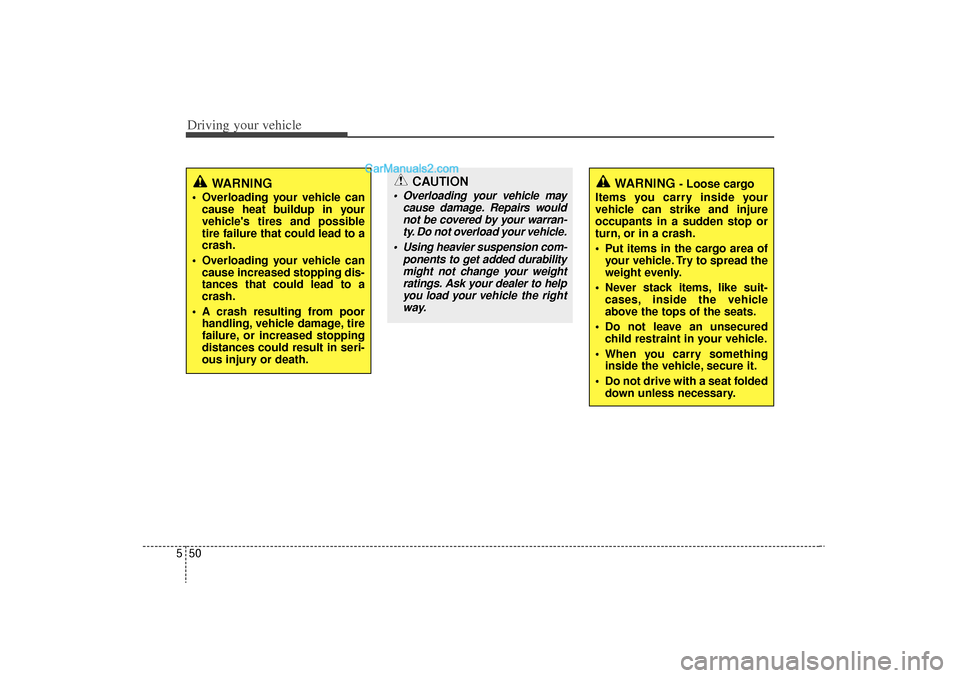
Driving your vehicle50
5
WARNING
Overloading your vehicle can
cause heat buildup in your
vehicle's tires and possible
tire failure that could lead to a
crash.
Overloading your vehicle can cause increased stopping dis-
tances that could lead to a
crash.
A crash resulting from poor handling, vehicle damage, tire
failure, or increased stopping
distances could result in seri-
ous injury or death.
WARNING
- Loose cargo
Items you carry inside your
vehicle can strike and injure
occupants in a sudden stop or
turn, or in a crash.
Put items in the cargo area of your vehicle. Try to spread the
weight evenly.
Never stack items, like suit- cases, inside the vehicle
above the tops of the seats.
Do not leave an unsecured child restraint in your vehicle.
When you carry something inside the vehicle, secure it.
Do not drive with a seat folded down unless necessary.
CAUTION
Overloading your vehicle may
cause damage. Repairs wouldnot be covered by your warran-ty. Do not overload your vehicle.
Using heavier suspension com- ponents to get added durabilitymight not change your weightratings. Ask your dealer to helpyou load your vehicle the rightway.
YF HMA 5.qxp 8/20/2010 5:46 PM Page 50
Page 273 of 390
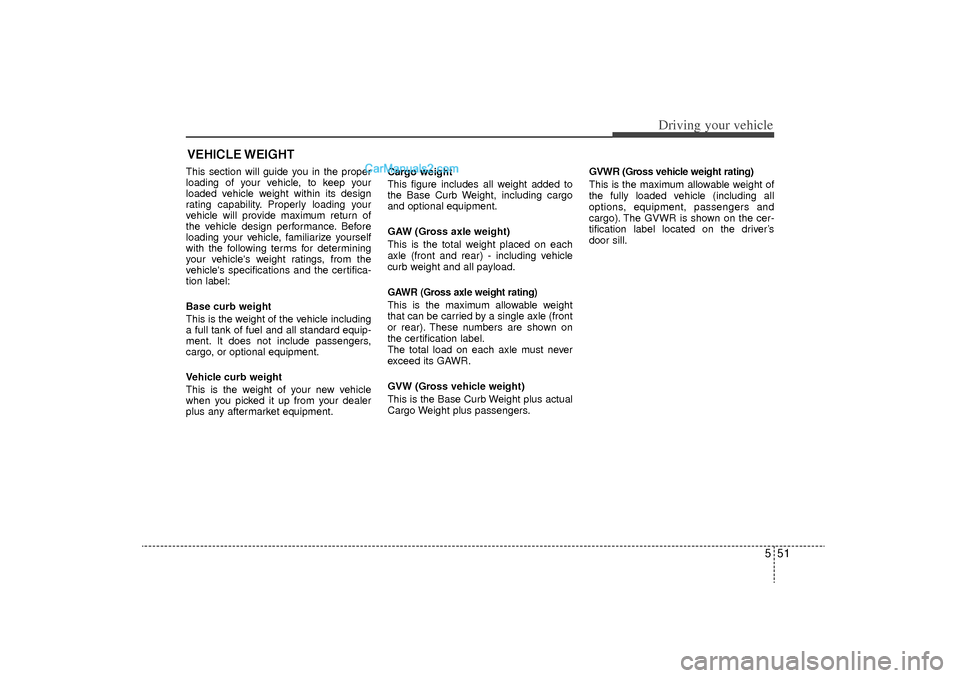
551
Driving your vehicle
This section will guide you in the proper
loading of your vehicle, to keep your
loaded vehicle weight within its design
rating capability. Properly loading your
vehicle will provide maximum return of
the vehicle design performance. Before
loading your vehicle, familiarize yourself
with the following terms for determining
your vehicle's weight ratings, from the
vehicle's specifications and the certifica-
tion label:
Base curb weight
This is the weight of the vehicle including
a full tank of fuel and all standard equip-
ment. It does not include passengers,
cargo, or optional equipment.
Vehicle curb weight
This is the weight of your new vehicle
when you picked it up from your dealer
plus any aftermarket equipment.Cargo weight
This figure includes all weight added to
the Base Curb Weight, including cargo
and optional equipment.
GAW (Gross axle weight)
This is the total weight placed on each
axle (front and rear) - including vehicle
curb weight and all payload.
GAWR (Gross axle weight rating)This is the maximum allowable weight
that can be carried by a single axle (front
or rear). These numbers are shown on
the certification label.
The total load on each axle must never
exceed its GAWR.
GVW (Gross vehicle weight)
This is the Base Curb Weight plus actual
Cargo Weight plus passengers.
GVWR (Gross vehicle weight rating)
This is the maximum allowable weight of
the fully loaded vehicle (including all
options, equipment, passengers and
cargo). The GVWR is shown on the cer-
tification label located on the driver’s
door sill.
VEHICLE WEIGHT
YF HMA 5.qxp 8/20/2010 5:46 PM Page 51
Page 332 of 390
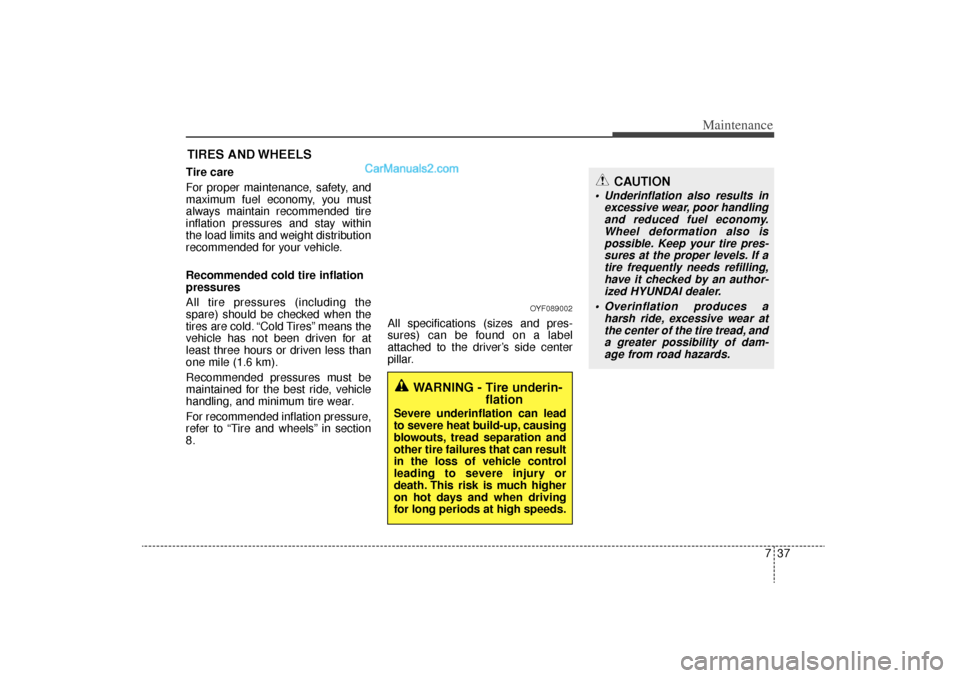
737
Maintenance
CAUTION
Underinflation also results inexcessive wear, poor handlingand reduced fuel economy.Wheel deformation also ispossible. Keep your tire pres-sures at the proper levels. If atire frequently needs refilling,have it checked by an author-ized HYUNDAI dealer.
Overinflation produces a harsh ride, excessive wear atthe center of the tire tread, anda greater possibility of dam-age from road hazards.
TIRES AND WHEELS Tire care
For proper maintenance, safety, and
maximum fuel economy, you must
always maintain recommended tire
inflation pressures and stay within
the load limits and weight distribution
recommended for your vehicle.
Recommended cold tire inflation
pressures
All tire pressures (including the
spare) should be checked when the
tires are cold. “Cold Tires” means the
vehicle has not been driven for at
least three hours or driven less than
one mile (1.6 km).
Recommended pressures must be
maintained for the best ride, vehicle
handling, and minimum tire wear.
For recommended inflation pressure,
refer to “Tire and wheels” in section
8. All specifications (sizes and pres-
sures) can be found on a label
attached to the driver’s side center
pillar.
WARNING - Tire underin-
flation
Severe underinflation can lead
to severe heat build-up, causing
blowouts, tread separation and
other tire failures that can result
in the loss of vehicle control
leading to severe injury or
death. This risk is much higher
on hot days and when driving
for long periods at high speeds.
OYF089002
YF HMA 7.qxp 8/24/2010 3:29 PM Page 37
Page 335 of 390
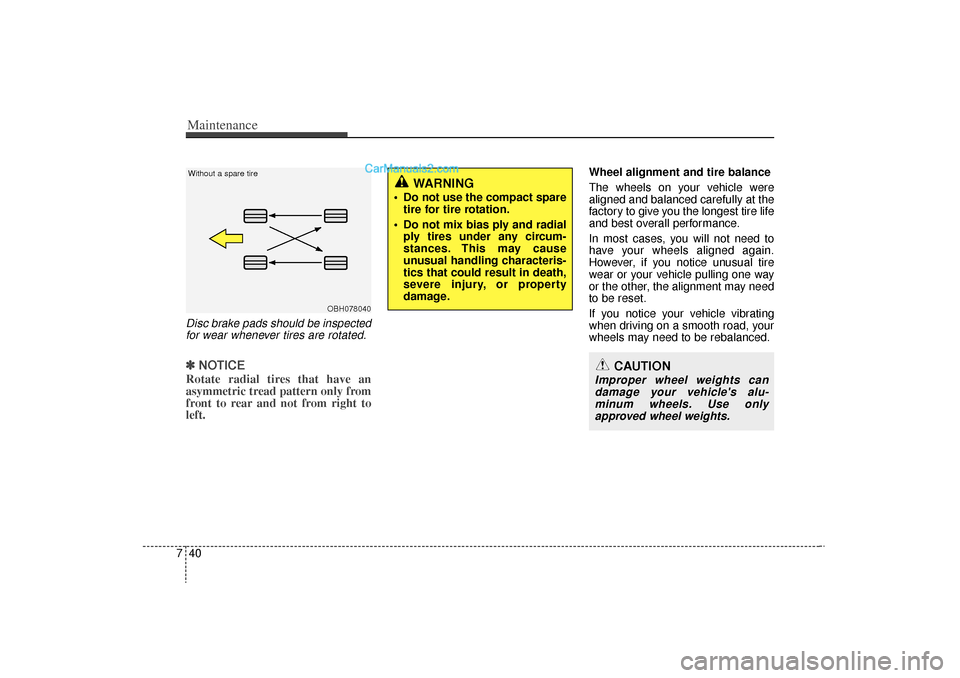
Maintenance40
7Disc brake pads should be inspected
for wear whenever tires are rotated.✽
✽ NOTICERotate radial tires that have an
asymmetric tread pattern only from
front to rear and not from right to
left.
Wheel alignment and tire balance
The wheels on your vehicle were
aligned and balanced carefully at the
factory to give you the longest tire life
and best overall performance.
In most cases, you will not need to
have your wheels aligned again.
However, if you notice unusual tire
wear or your vehicle pulling one way
or the other, the alignment may need
to be reset.
If you notice your vehicle vibrating
when driving on a smooth road, your
wheels may need to be rebalanced.
OBH078040
Without a spare tire
WARNING
Do not use the compact spare
tire for tire rotation.
Do not mix bias ply and radial ply tires under any circum-
stances. This may cause
unusual handling characteris-
tics that could result in death,
severe injury, or property
damage.
CAUTION
Improper wheel weights candamage your vehicle's alu-minum wheels. Use onlyapproved wheel weights.
YF HMA 7.qxp 8/24/2010 3:29 PM Page 40
Page 341 of 390
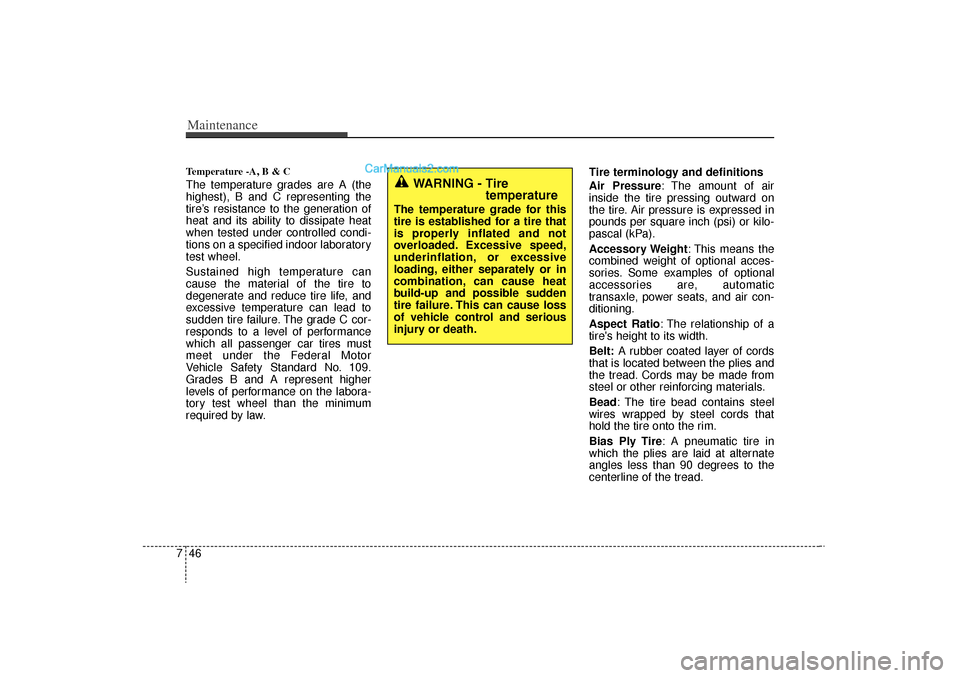
Maintenance46
7Temperature -A, B & C The temperature grades are A (the
highest), B and C representing the
tire’s resistance to the generation of
heat and its ability to dissipate heat
when tested under controlled condi-
tions on a specified indoor laboratory
test wheel.
Sustained high temperature can
cause the material of the tire to
degenerate and reduce tire life, and
excessive temperature can lead to
sudden tire failure. The grade C cor-
responds to a level of performance
which all passenger car tires must
meet under the Federal Motor
Vehicle Safety Standard No. 109.
Grades B and A represent higher
levels of performance on the labora-
tory test wheel than the minimum
required by law. Tire terminology and definitions
Air Pressure: The amount of air
inside the tire pressing outward on
the tire. Air pressure is expressed in
pounds per square inch (psi) or kilo-
pascal (kPa).
Accessory Weight
: This means the
combined weight of optional acces-
sories. Some examples of optional
accessories are, automatic
transaxle, power seats, and air con-
ditioning.
Aspect Ratio: The relationship of a
tire's height to its width.
Belt: A rubber coated layer of cords
that is located between the plies and
the tread. Cords may be made from
steel or other reinforcing materials.
Bead: The tire bead contains steel
wires wrapped by steel cords that
hold the tire onto the rim.
Bias Ply Tire : A pneumatic tire in
which the plies are laid at alternate
angles less than 90 degrees to the
centerline of the tread.
WARNING - Tire temperature
The temperature grade for this
tire is established for a tire that
is properly inflated and not
overloaded. Excessive speed,
underinflation, or excessive
loading, either separately or in
combination, can cause heat
build-up and possible sudden
tire failure. This can cause loss
of vehicle control and serious
injury or death.
YF HMA 7.qxp 8/24/2010 3:29 PM Page 46
Page 342 of 390
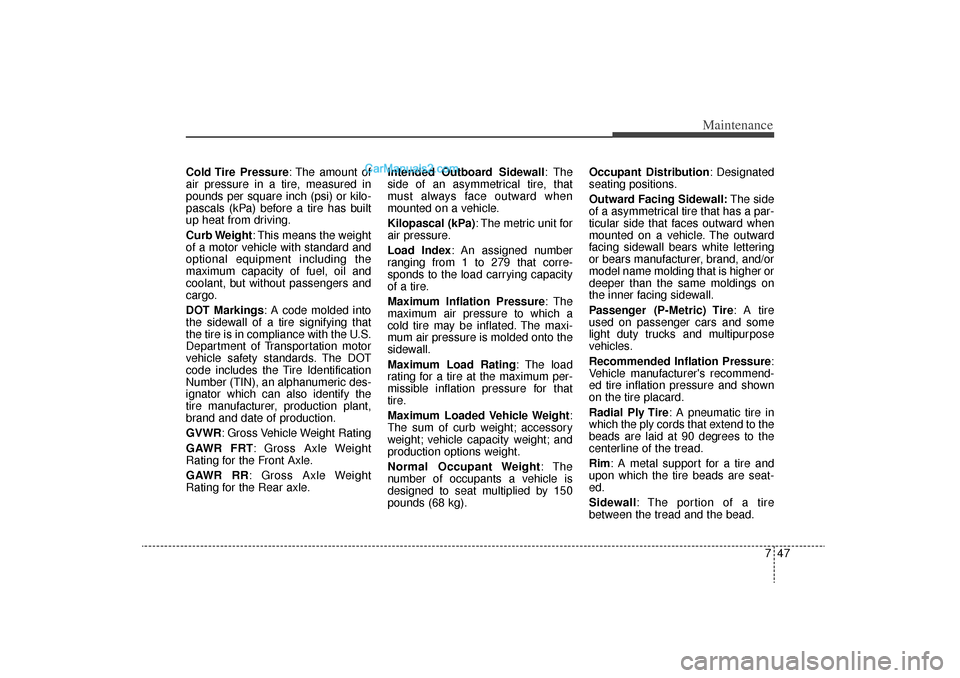
747
Maintenance
Cold Tire Pressure: The amount of
air pressure in a tire, measured in
pounds per square inch (psi) or kilo-
pascals (kPa) before a tire has built
up heat from driving.
Curb Weight: This means the weight
of a motor vehicle with standard and
optional equipment including the
maximum capacity of fuel, oil and
coolant, but without passengers and
cargo.
DOT Markings: A code molded into
the sidewall of a tire signifying that
the tire is in compliance with the U.S.
Department of Transportation motor
vehicle safety standards. The DOT
code includes the Tire Identification
Number (TIN), an alphanumeric des-
ignator which can also identify the
tire manufacturer, production plant,
brand and date of production.
GVWR: Gross Vehicle Weight Rating
GAWR FRT: Gross Axle Weight
Rating for the Front Axle.
GAWR RR: Gross Axle Weight
Rating for the Rear axle.Intended Outboard Sidewall
: The
side of an asymmetrical tire, that
must always face outward when
mounted on a vehicle.
Kilopascal (kPa): The metric unit for
air pressure.
Load Index: An assigned number
ranging from 1 to 279 that corre-
sponds to the load carrying capacity
of a tire.
Maximum Inflation Pressure : The
maximum air pressure to which a
cold tire may be inflated. The maxi-
mum air pressure is molded onto the
sidewall.
Maximum Load Rating : The load
rating for a tire at the maximum per-
missible inflation pressure for that
tire.
Maximum Loaded Vehicle Weight :
The sum of curb weight; accessory
weight; vehicle capacity weight; and
production options weight.
Normal Occupant Weight: The
number of occupants a vehicle is
designed to seat multiplied by 150
pounds (68 kg). Occupant Distribution
: Designated
seating positions.
Outward Facing Sidewall: The side
of a asymmetrical tire that has a par-
ticular side that faces outward when
mounted on a vehicle. The outward
facing sidewall bears white lettering
or bears manufacturer, brand, and/or
model name molding that is higher or
deeper than the same moldings on
the inner facing sidewall.
Passenger (P-Metric) Tire : A tire
used on passenger cars and some
light duty trucks and multipurpose
vehicles.
Recommended Inflation Pressure :
Vehicle manufacturer's recommend-
ed tire inflation pressure and shown
on the tire placard.
Radial Ply Tire : A pneumatic tire in
which the ply cords that extend to the
beads are laid at 90 degrees to the
centerline of the tread.
Rim: A metal support for a tire and
upon which the tire beads are seat-
ed.
Sidewall: The portion of a tire
between the tread and the bead.
YF HMA 7.qxp 8/24/2010 3:29 PM Page 47
Page 343 of 390
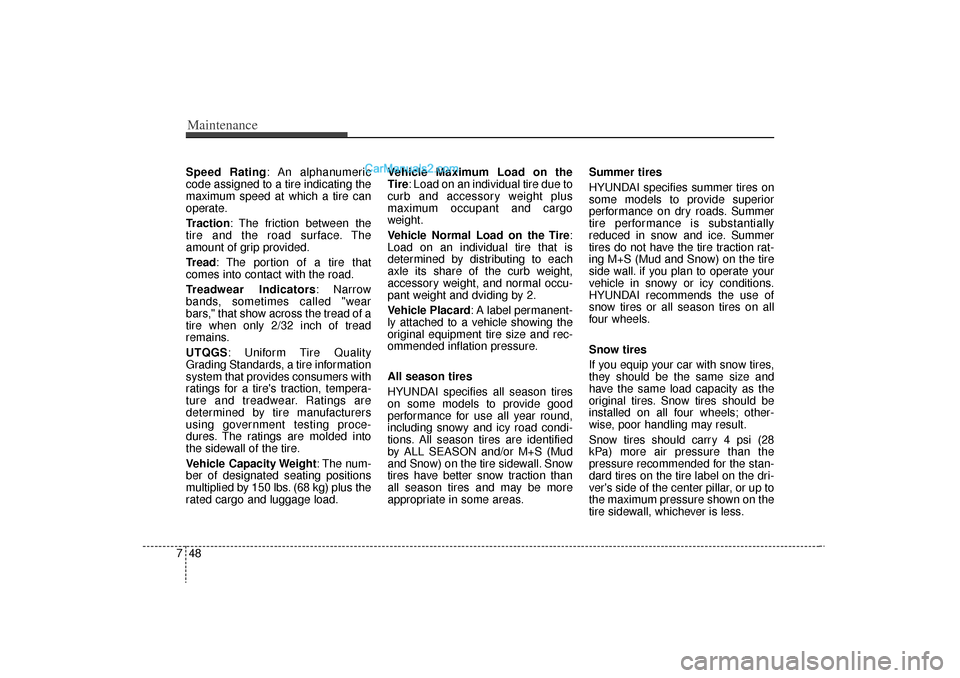
Maintenance48
7Speed Rating: An alphanumeric
code assigned to a tire indicating the
maximum speed at which a tire can
operate.
Traction: The friction between the
tire and the road surface. The
amount of grip provided.
Tread: The portion of a tire that
comes into contact with the road.
Treadwear Indicators: Narrow
bands, sometimes called "wear
bars," that show across the tread of a
tire when only 2/32 inch of tread
remains.
UTQGS: Uniform Tire Quality
Grading Standards, a tire information
system that provides consumers with
ratings for a tire's traction, tempera-
ture and treadwear. Ratings are
determined by tire manufacturers
using government testing proce-
dures. The ratings are molded into
the sidewall of the tire.
Vehicle Capacity Weight : The num-
ber of designated seating positions
multiplied by 150 lbs. (68 kg) plus the
rated cargo and luggage load. Vehicle Maximum Load on the
Tire: Load on an individual tire due to
curb and accessory weight plus
maximum occupant and cargo
weight.
Vehicle Normal Load on the Tire
:
Load on an individual tire that is
determined by distributing to each
axle its share of the curb weight,
accessory weight, and normal occu-
pant weight and dviding by 2.
Vehicle Placard: A label permanent-
ly attached to a vehicle showing the
original equipment tire size and rec-
ommended inflation pressure.
All season tires
HYUNDAI specifies all season tires
on some models to provide good
performance for use all year round,
including snowy and icy road condi-
tions. All season tires are identified
by ALL SEASON and/or M+S (Mud
and Snow) on the tire sidewall. Snow
tires have better snow traction than
all season tires and may be more
appropriate in some areas. Summer tires
HYUNDAI specifies summer tires on
some models to provide superior
performance on dry roads. Summer
tire performance is substantially
reduced in snow and ice. Summer
tires do not have the tire traction rat-
ing M+S (Mud and Snow) on the tire
side wall. if you plan to operate your
vehicle in snowy or icy conditions.
HYUNDAI recommends the use of
snow tires or all season tires on all
four wheels.
Snow tires
If you equip your car with snow tires,
they should be the same size and
have the same load capacity as the
original tires. Snow tires should be
installed on all four wheels; other-
wise, poor handling may result.
Snow tires should carry 4 psi (28
kPa) more air pressure than the
pressure recommended for the stan-
dard tires on the tire label on the dri-
ver's side of the center pillar, or up to
the maximum pressure shown on the
tire sidewall, whichever is less.
YF HMA 7.qxp 8/24/2010 3:29 PM Page 48
Page 351 of 390
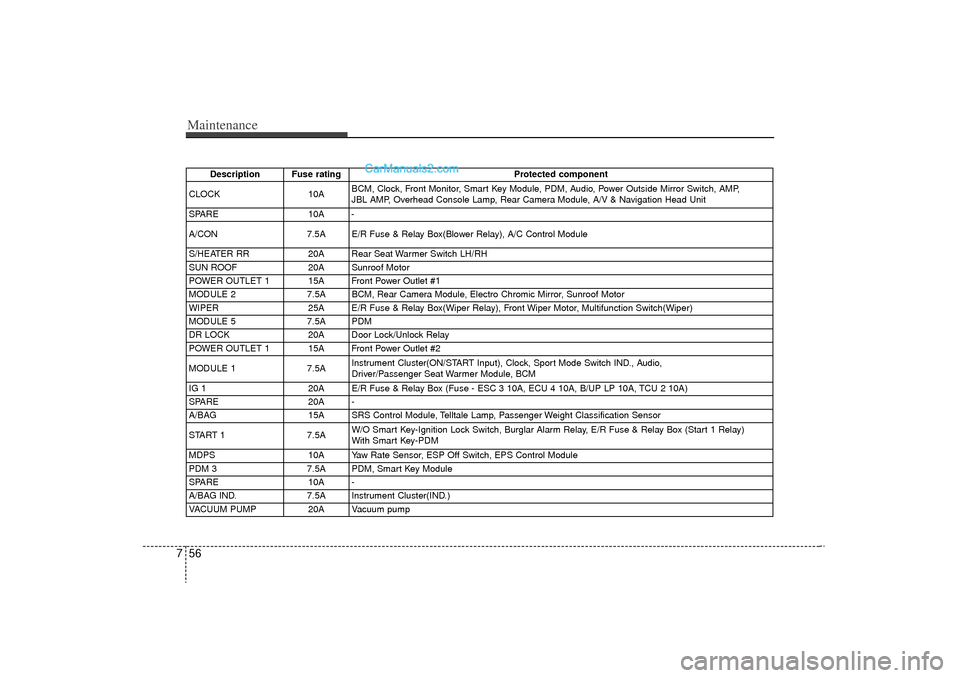
Maintenance56
7
Description Fuse rating Protected component
CLOCK 10ABCM, Clock, Front Monitor, Smart Key Module, PDM, Audio, Power Outside Mirror Switch, AMP,
JBL AMP, Overhead Console Lamp, Rear Camera Module, A/V & Navigation Head Unit
SPARE 10A -
A/CON 7.5A E/R Fuse & Relay Box(Blower Relay), A/C Control Module
S/HEATER RR 20A Rear Seat Warmer Switch LH/RH
SUN ROOF 20A Sunroof Motor
POWER OUTLET 1 15A Front Power Outlet #1
MODULE 2 7.5A BCM, Rear Camera Module, Electro Chromic Mirror, Sunroof Motor
WIPER 25A E/R Fuse & Relay Box(Wiper Relay), Front Wiper Motor, Multifunction Switch(Wiper)
MODULE 5 7.5A PDM
DR LOCK 20A Door Lock/Unlock Relay
POWER OUTLET 1 15A Front Power Outlet #2
MODULE 1 7.5AInstrument Cluster(ON/START Input), Clock, Sport Mode Switch IND., Audio,
Driver/Passenger Seat Warmer Module, BCM
IG 1 20A E/R Fuse & Relay Box (Fuse - ESC 3 10A, ECU 4 10A, B/UP LP 10A, TCU 2 10A)
SPARE 20A -
A/BAG 15A SRS Control Module, Telltale Lamp, Passenger Weight Classification Sensor
START 1 7.5AW/O Smart Key-Ignition Lock Switch, Burglar Alarm Relay, E/R Fuse & Relay Box (Start 1 Relay)
With Smart Key-PDM
MDPS 10A Yaw Rate Sensor, ESP Off Switch, EPS Control Module
PDM 3 7.5A PDM, Smart Key Module
SPARE 10A -
A/BAG IND. 7.5A Instrument Cluster(IND.)
VACUUM PUMP
20A
Vacuum pump
YF HMA 7.qxp 8/24/2010 3:30 PM Page 56
Page 383 of 390
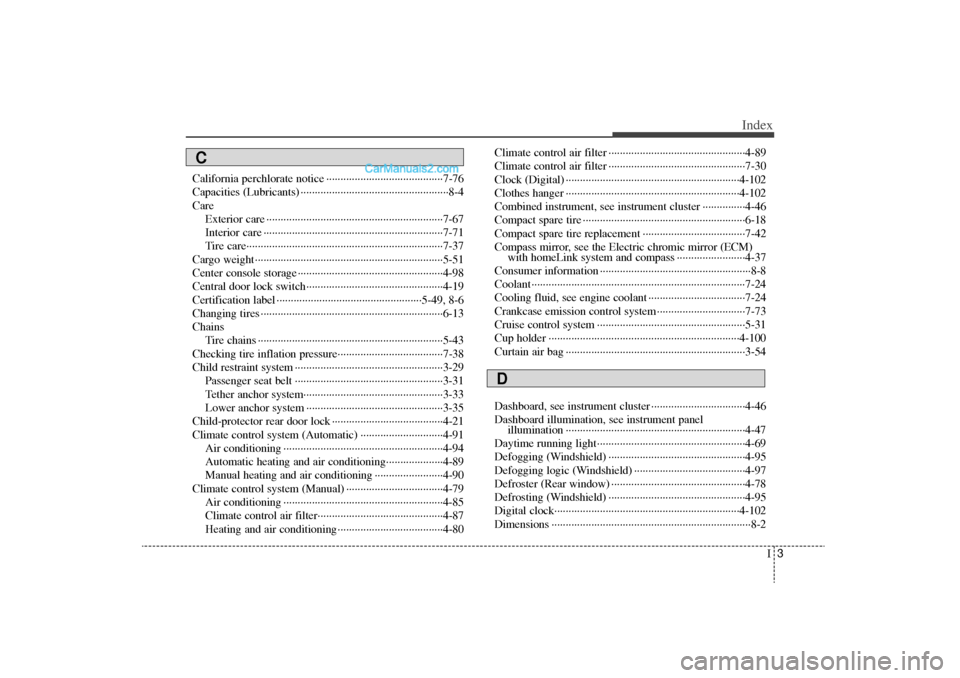
I3
Index
California perchlorate notice ··················\
··················\
·····7-76
Capacities (Lubricants) ··················\
··················\
················8-4
CareExterior care ··················\
··················\
··················\
········7-67
Interior care ··················\
··················\
··················\
·········7-71
Tire care··················\
··················\
··················\
···············7-37
Cargo weight ··················\
··················\
··················\
············5-51
Center console storage ··················\
··················\
···············4-98
Central door lock switch··················\
··················\
············4-19
Certification label ··················\
··················\
···············5-49, 8-6
Changing tires ··················\
··················\
··················\
··········6-13
Chains Tire chains ··················\
··················\
··················\
···········5-43
Checking tire inflation pressure··················\
··················\
·7-38
Child restraint system ··················\
··················\
················3-29 Passenger seat belt ··················\
··················\
················3-31
Tether anchor system··················\
··················\
·············3-33
Lower anchor system ··················\
··················\
············3-35
Child-protector rear door lock ··················\
··················\
···4-21
Climate control system (Automatic) ··················\
···········4-91 Air conditioning ··················\
··················\
··················\
··4-94
Automatic heating and air conditioning··················\
··4-89
Manual heating and air conditioning ··················\
······4-90
Climate control system (Manual) ··················\
················4-79 Air conditioning ··················\
··················\
··················\
··4-85
Climate control air filter··················\
··················\
········4-87
Heating and air conditioning··················\
··················\
·4-80 Climate control air filter ··················\
··················\
············4-89
Climate control air filter ··················\
··················\
············7-30
Clock (Digital) ··················\
··················\
··················\
·······4-102
Clothes hanger ··················\
··················\
··················\
·······4-102
Combined instrument, see instrument cluster ···············4-46
Compact spare tire ··················\
··················\
··················\
···6-18
Compact spare tire replacement ··················\
··················\
7-42
Compass mirror, see the Electric chromic mirror (ECM)
with homeLink system and compass ··················\
······4-37
Consumer information ··················\
··················\
·················8-8
Coolant ··················\
··················\
··················\
··················\
···7-24
Cooling fluid, see engine coolant ··················\
················7-24
Crankcase emission control system ··················\
·············7-73
Cruise control system ··················\
··················\
················5-31
Cup holder ··················\
··················\
··················\
·············4-100
Curtain air bag ··················\
··················\
··················\
·········3-54
Dashboard, see instrument cluster ··················\
···············4-46
Dashboard illumination, see instrument panel illumination ··················\
··················\
··················\
·········4-47
Daytime running light··················\
··················\
················4-69
Defogging (Windshield) ··················\
··················\
············4-95
Defogging logic (Windshield) ··················\
··················\
···4-97
Defroster (Rear window) ··················\
··················\
···········4-78
Defrosting (Windshield) ··················\
··················\
············4-95
Digital clock··················\
··················\
··················\
···········4-102
Dimensions ··················\
··················\
··················\
················8-2C
D
YF HMA INDEX.QXP 8/24/2010 1:05 PM Page 3
Page 390 of 390
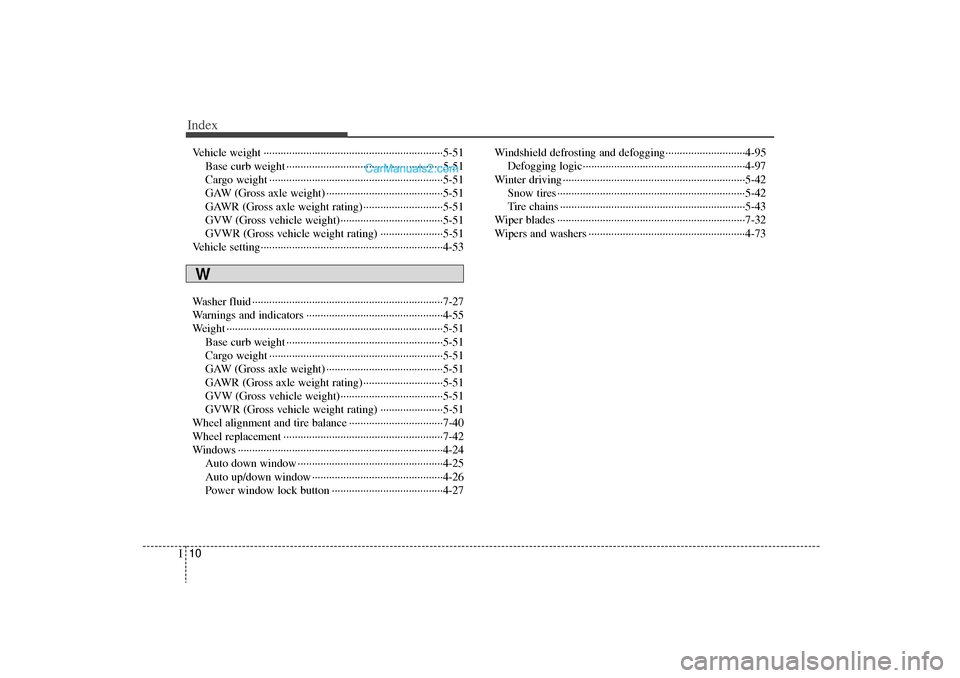
Index10I
Vehicle weight ··················\
··················\
··················\
·········5-51Base curb weight ··················\
··················\
··················\
·5-51
Cargo weight ··················\
··················\
··················\
·······5-51
GAW (Gross axle weight) ··················\
··················\
·····5-51
GAWR (Gross axle weight rating)··················\
··········5-51
GVW (Gross vehicle weight)··················\
··················\
5-51
GVWR (Gross vehicle weight rating) ··················\
····5-51
Vehicle setting··················\
··················\
··················\
··········4-53
Washer fluid ··················\
··················\
··················\
·············7-27
Warnings and indicators ··················\
··················\
············4-55
Weight ··················\
··················\
··················\
··················\
····5-51 Base curb weight ··················\
··················\
··················\
·5-51
Cargo weight ··················\
··················\
··················\
·······5-51
GAW (Gross axle weight) ··················\
··················\
·····5-51
GAWR (Gross axle weight rating)··················\
··········5-51
GVW (Gross vehicle weight)··················\
··················\
5-51
GVWR (Gross vehicle weight rating) ··················\
····5-51
Wheel alignment and tire balance ··················\
···············7-40
Wheel replacement ··················\
··················\
··················\
··7-42
Windows ··················\
··················\
··················\
··················\
4-24 Auto down window ··················\
··················\
···············4-25
Auto up/down window ··················\
··················\
··········4-26
Power window lock button ··················\
··················\
···4-27 Windshield defrosting and defogging··················\
··········4-95
Defogging logic··················\
··················\
··················\
···4-97
Winter driving ··················\
··················\
··················\
··········5-42 Snow tires ··················\
··················\
··················\
············5-42
Tire chains ··················\
··················\
··················\
···········5-43
Wiper blades ··················\
··················\
··················\
············7-32
Wipers and washers ··················\
··················\
··················\
·4-73W
YF HMA INDEX.QXP 8/24/2010 1:05 PM Page 10